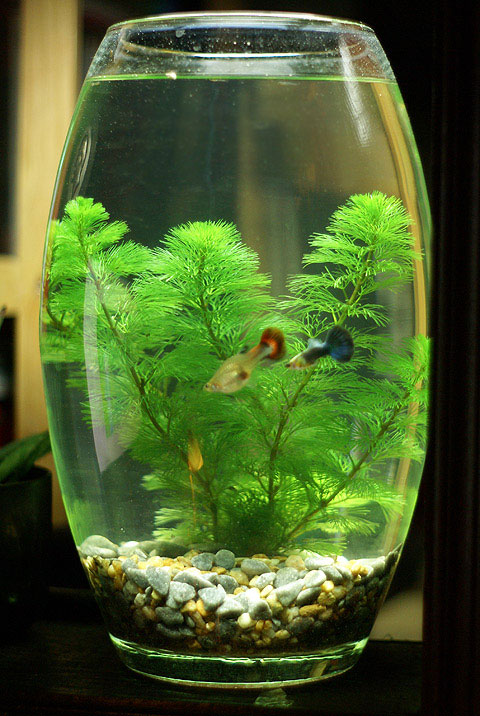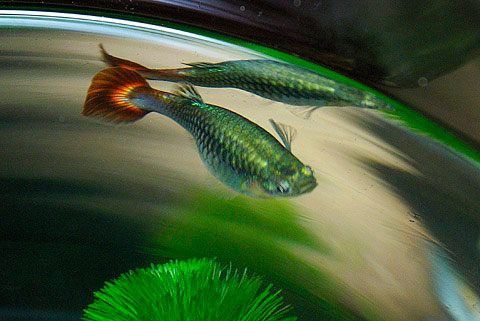Watch guppies laying babies
The vast majority of us think that fish can only lay eggs, but there are also fish that can give birth, in which guppies are an example.
With colorful, vivacious and easy-to-farm colors, guppies have become the world's most popular ornamental fish . For those who used to breed guppies, he rarely experienced an interesting experience in the "spawning" phenomenon of this fish.
Guppies are one of the few fish species that reproduce in the form of a fetus . Eggs after fertilization inside the body of the mother's mother remain in the fallopian tube. Instead of taking maternal nutrition as a form of pregnancy in mammals, in the guppies, the embryo will develop thanks to the yolk stock.
In terms of glass tank culture, reproduction of guppies takes place very easily. However, since fish are usually born in the night and early in the morning, not everyone has the conditions to witness firsthand the breeding process of guppies.
Images of the "baby" phenomenon in guppies
 Most of the time of the day, even when pregnant, female guppies (red) are always pursued by males (black) because this species has a habit of "laying off".
Most of the time of the day, even when pregnant, female guppies (red) are always pursued by males (black) because this species has a habit of "laying off".

After conceiving 20 to 30 days, the mother with a "pregnant belly" can hold up to 50 fry and is ready for delivery.

To give birth to a single litter, the mother may take several hours.Most fry come out first.

But not a few of them were born with their tails as shown in the picture.

About 5mm long, from the womb, newborn guppies "free fall" onto the seaweed or tank background.

After a few minutes, the fry began to become lively and swim at the first beat.

Instinct teaches them that dog tail leaves are safe hiding places, and also a source of initial food.

They also understand that swarming is a way to confuse the direction of the enemy.

Ironically, with the behavior of eating children, the first enemy of fry is broodstock.

Powdered fish gather on the water surface to heat under the neon lamp.About 40 newborn babies were born in this parity.If surviving, after more than a month, the fry will mature and be ready to produce new generations of fish.
How to take care of baby guppies
Poecilia reticulata , a species of Poeciliidae , is a species of the Poeciliidae family. This species originated in South America, but has been introduced into many lakes and rivers of many countries in the role of an anti-dengue agent, because it is a bug-killing species.
In the first stage after calving, broodstock are very easy to attack young fish. Therefore, in the breeding pond of guppies, it is necessary to design " safe spots " for fry such as adding a net frame. Use nylon mesh, wire mesh, smooth, small mesh. This type of net only allows the fry to pass through, keeping the broodstock in the remaining part of the lake, completely isolated from the fry. The net is fixed to the wooden frame, the wooden frame is designed according to the width (width) of each aquarium.

Place the net in the aquarium, divide the pond into two parts, maybe 1/3 is where the baby fish live, the remaining 2/3 is where the broodstock live. Or you can use plastic baskets with a diameter of 10 - 15 cm, with small holes that relatively prevent parents.
Drop baskets all over the surface of the aquarium, the young fish will "drift" into the basket to find shelter, hiding while parents cannot enter. It is also possible to use nets, stretching 5 to 10 cm from the water surface, restricting the passage of parents because the fry often live near the water. In some places, use a rolled-up net, drop it around the lake, as a hiding place for young fish. In addition, collecting, collecting and transferring baby fish to a private pond is also a positive solution. However, it is easy to shock the fry due to sudden changes in the living environment .
Want a stable environment, need to prepare the lake a few days earlier, pay attention to the water level, temperature, alum, oxygen content . These factors allow a difference of not more than 10% between the old environment and new. In addition to the above measures, during the process of broodstock rearing, the period of broodstock breeding, need to supplement the food, ensure the parents are not hungry. Always keep the environment stable, quiet, avoid sudden shock, noise . are measures to reduce the loss of newborn guppies.
- Video: The reason some snakes give birth instead of laying eggs
- Video: Close-up of male seahorses laying 2,000 birds at once
- Observe the extremely rare 'reverse evolution' lizard species in the natural world for the first time
- Guppies can destroy the natural ecological environment
- Mother snake laying dozens of snakes?
- Will babies who breastfed out be better?
- Are guppies more carnivorous than tigers and sharks?
- Strange 12-year-old boy a week ... laid out 7 eggs?
- Where does the child cry most?
- The secret of babies
- Strange rock knows 'spawn'
- Miraculous abilities of babies
 Animal 'suffering' after hibernation
Animal 'suffering' after hibernation Why do goats climb well?
Why do goats climb well? Scientists were surprised to see chimpanzees eating turtles
Scientists were surprised to see chimpanzees eating turtles Giant catfish died deadly due to drought in Thailand
Giant catfish died deadly due to drought in Thailand